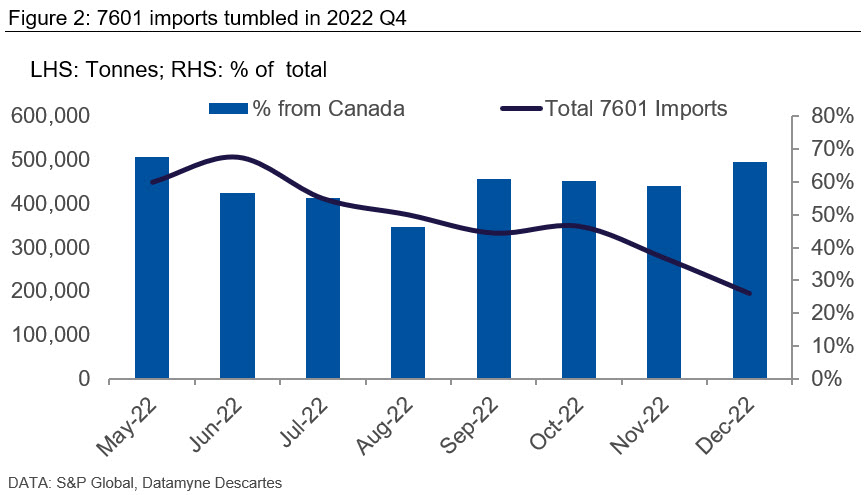During the month of January, the US Midwest premium has risen by close to 40% over where 2022 ended. This comes after close to two months of little volatility which makes the rapid move up even more jarring. It is not the first time the premium has exhibited this behaviour, although in the past there were clear catalysts such as sanctions or geopolitical events. This time, however, current market conditions, an unsustainably low premium during year end 2022, and market fundamentals all played a role.

Author Matthew Abrams
Research Analyst View profile
The US market is still historically tight
The balance in the US is still very tight with low stock levels. Throughout the year, power prices caused further curtailments with the Hawesville smelter being the key example. Tight conditions tend to increase the sensitivity of the market to shifts in the fundamentals such as demand. This in turn makes periods of low stock more volatile which was very noticeable over the past 18 months.

End of year conditions allowed low levels to hang around
Conditions slowed noticeably during year end 2022 for the first time since the post pandemic frenzy began. This slowdown affected both the physical and trading markets and can be visualised in three charts.
A drop in imports: A historically high amount of primary aluminium imports came into the US during the first half of 2022. This slowed down significantly in both November and December, dropping by 21% which was down more than 45% from the peak in June. As a result, imports from Canada hit just over 66%, as they remained consistent while overall imports dropped, which put more downward pressure on the premium.

New order indexes also dropped: New orders as reported by the Aluminum Association fell to levels seen last in mid-2021 during the pandemic related recession and before that has been a historical trough level.

Trading activity also dipped: Throughout 2022 Q4, trading activity was also reported as slowing. While the previous physical market trends were a large part of the reason, short term spreads on both the LME and CME were tight which further suppressed market activity.

Conditions in the new year facilitated a market correction
In the first week of the new year, conditions flipped on their head. Economic sentiment improved and trading picked back up almost immediately after the holiday period. The tightness of the market came into play again as the region still requires imports to sustain production and netbacks need to compete with other regions. Ocean freight, inland trucking rates, and the LME jump all worked to make replacement levels what they are today.
Freight remains above historical averages: Ocean freight and inland trucking rates both fell in mid-2022. Despite the drastic drop, both continue to sit above historical averages.

The LME rallied higher in January: The premium was not the only price to rally in the new year as the LME also shot up close to $300/t over the lowest point in the beginning of January. When applying the 10% 232 duty, this accounts for an extra two cents per pound. While a small amount, this is important when realising January 2023 was already starting to trade at 24.5 ¢/lb on the futures curve in late 2022 and this helps account for the rise to over 29 ¢/lb.

A reversion back to replacement level was necessary: The above factors all translate to replacement costs of around 28 ¢/lb. As mentioned, inventories in the US remain low and the market is tight. The region must continue to attract foreign metal and netbacks need to be competitive to do that.

Looking at it through this lens, the premium at year end was unsustainably low. The lack of activity in the market combined with strong negative sentiment to lower the premium. As soon as sentiment turned less negative and substantial trading activity returned, the market quickly corrected to a higher level. While risks remain, it is likely that the premium settles down around its current point but will continue to drift upward should better sentiment continue to build and translate to positive demand growth.
Explore this topic with CRU
Author Matthew Abrams
Research Analyst View profile